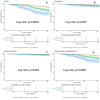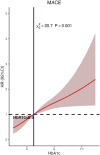Impact of haemoglobinA1c on platelet reactivity and cardiovascular outcomes in patients undergoing drug-eluting stent implantation
- PMID: 39613892
- PMCID: PMC11607451
- DOI: 10.1038/s41598-024-81537-1
Impact of haemoglobinA1c on platelet reactivity and cardiovascular outcomes in patients undergoing drug-eluting stent implantation
Abstract
This study investigates the impact of hemoglobin A1c on platelet reactivity and cardiovascular outcomes in patients undergoing drug-eluting stent implantation. HbA1c levels were categorized into 3 groups: < 6.5%, 6.5-8.5%, and > 8.5%. ROC (resistance to clopidogrel) and ROA (resistance to aspirin) were calculated. The primary endpoint was a composite of MACE, including all-cause mortality, nonfatal MI, and ischemia-driven revascularization. The secondary endpoints comprised individual MACE components. The incidence of ROC was 9.3% (151 of 1621), whereas that of ROA was 16.5% (268 of 1621). The ROC for each of the 3 groups significantly increased with increasing HbA1c levels [4.3% vs. 7.1% vs. 10.1%, p = 0.006]; however, the ROA did not [16.4% vs. 17.7% vs. 14.3%, P = 0.694]. HbA1c > 8.5 was significantly associated with ROC (3.356 [1.231, 9.234], p = 0.009). Compared with the HbA1c < 6.5 subgroup, the HbA1c˃8.5 subgroup was significantly associated with MACE (3.142 [2.346, 4.206], < 0.001), nonfatal MI (2.297 [1.275, 4.137], P = 0.006) and ischemia-driven revascularization (3.845 [2.082, 7.101], p < 0.001), but not all-cause mortality (2.371 [0.551, 10.190], 0.246) at the 36-month follow-up. HbA1c levels were positively correlated with ROC, but the adverse cardiovascular events were driven by elevated HbA1c, constituting an argument to intensify glycemic control in subjects with diabetes after intracoronary stent placement.
Keywords: Atherosclerosis; Glycated hemoglobin; Percutaneous coronary intervention; Platelet reactivity.
© 2024. The Author(s).
Conflict of interest statement
Declarations. Competing interests: The authors declare no competing interests. Ethics approval and consent to participate: The study protocols were approval by the Ethics Committee of Jiading Branch of Shanghai General Hospital and performed in accordance with the Declaration of Helsinki. All participants provided written informed consent to participate in the study.
Figures




Similar articles
-
Impact of Hemoglobin A1c Levels on Residual Platelet Reactivity and Outcomes After Insertion of Coronary Drug-Eluting Stents (from the ADAPT-DES Study).Am J Cardiol. 2016 Jan 15;117(2):192-200. doi: 10.1016/j.amjcard.2015.10.037. Epub 2015 Nov 6. Am J Cardiol. 2016. PMID: 26639039 Clinical Trial.
-
Impact of Aspirin and Clopidogrel Hyporesponsiveness in Patients Treated With Drug-Eluting Stents: 2-Year Results of a Prospective, Multicenter Registry Study.JACC Cardiovasc Interv. 2017 Aug 28;10(16):1607-1617. doi: 10.1016/j.jcin.2017.05.059. Epub 2017 Aug 2. JACC Cardiovasc Interv. 2017. PMID: 28780034
-
High platelet reactivity affects the clinical outcomes of patients undergoing percutaneous coronary intervention.BMC Cardiovasc Disord. 2016 Nov 29;16(1):240. doi: 10.1186/s12872-016-0394-0. BMC Cardiovasc Disord. 2016. PMID: 27894260 Free PMC article.
-
Safety and efficacy of policosanol in patients with high on-treatment platelet reactivity after drug-eluting stent implantation: two-year follow-up results.Cardiovasc Ther. 2016 Oct;34(5):337-42. doi: 10.1111/1755-5922.12204. Cardiovasc Ther. 2016. PMID: 27328023 Clinical Trial.
-
Platelet reactivity and clinical outcomes after coronary artery implantation of drug-eluting stents (ADAPT-DES): a prospective multicentre registry study.Lancet. 2013 Aug 17;382(9892):614-23. doi: 10.1016/S0140-6736(13)61170-8. Epub 2013 Jul 26. Lancet. 2013. PMID: 23890998 Clinical Trial.
References
-
- Sagar, R. C., Naseem, K. M. & Ajjan, R. A. Antiplatelet therapies in diabetes. Diabet. Med.37(5), 726–734 (2020). - PubMed
-
- Vazzana, N., Ranalli, P., Cuccurullo, C. & Davì, G. Diabetes mellitus and thrombosis. Thromb. Res.129(3), 371–377 (2012). - PubMed
-
- Campo, G. et al. Long-term clinical outcome based on aspirin and clopidogrel responsiveness status after elective percutaneous coronary intervention: a 3T/2R (tailoring treatment with tirofiban in patients showing resistance to aspirin and/or resistance to clopidogrel) trial substudy. J. Am. Coll. Cardiol.56, 1447e1455 (2010). - PubMed
-
- Price, M. J. et al. Platelet reactivity and cardiovascular outcomes after percutaneous coronary intervention: a time-dependent analysis of the gauging responsiveness with a VerifyNowP2Y12 assay: impact on thrombosis and safety (GRAVITAS). Trial Circ. 124, 1132–1137 (2011). - PubMed
MeSH terms
Substances
Grants and funding
LinkOut - more resources
Full Text Sources
Medical

